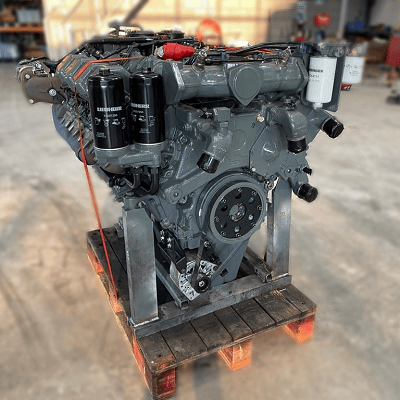The process of a dyno test on a Liebherr engine

When it comes to heavy machinery, reliability and power are paramount. Liebherr, a name synonymous with innovation and excellence in engineering, stands tall as a pioneer in the realm of heavy equipment and machinery. From towering cranes to robust excavators, Liebherr’s engineering prowess extends to the heart of these machines. We delve into the world of dyno testing a Liebherr engine, uncovering the meticulous process behind unleashing the raw power concealed within.
The foundation of excellence
Before we embark on the journey of dyno testing, it’s crucial to understand the foundation upon which Liebherr engines are built. With decades of engineering expertise and commitment to quality, Liebherr engines are crafted to withstand the most demanding environment and deliver unparalleled performance. Each component is meticulously designed and rigorously tested to ensure reliability, efficiency and longevity.
The process
1 Preparation: The engine undergoes meticulous preparation before being mounted onto the dynamo meter. This includes ensuring all connections are secure, fluids are filled to the appropriate levels, and sensors are properly calibrated.
2 Mounting: The engine is carefully mounted onto the dynamometer, a specialized device designed to simulate real-world operating conditions. Precision is paramount during this step to ensure accurate results.
3 Initial checks: Once mounted, a series of initial checks are conducted to verify proper alignment, connection integrity, and functionality of all engine systems.
4 Warm-up: The engine is started and allowed to warm up to operating temperature. This ensures consistent results and minimizes the risk of damage during testing.
5 Baseline testing: With the engine warmed up , baseline tests are conducted to establish initial performance metrics. This includes measuring power output, torque, fuel consumption, and emissions at various RPM levels.
6 Load testing: The engine is subjected to progressively increasing loads to simulate different operating conditions, such as idle, partial load and full load. This allows engineers to assess performance across the entire operating range and identify any potential issues or optimization.
7 Data analysis: Throughout the testing process, data is continuously collected and analyzed in real-time. Advanced instrumentation and software are used to monitor performance metrics and identify trends or anomalies.
8 Optimazation: Based on the data analysis, adjustments may be made to optimize engine performance. This could involve fine-tuning fuel injection timing, adjusting air-fuel ratios, or optimize turbocharger boost pressure.
9 Validation: Once testing is complete, the results are meticulously reviewed and validated against predetermined criteria and specifications. Any deviations or anomalies are thoroughly investigated to ensure accuracy and reliability.
10 Reporting: Finally, a comprehensive report is generated detailing the results of the dyno testing, including performance metrics, observations, and any recommendations for further optimization or refinement.
The outcome of dyno testing
Dyno testing a Liebherr engine is more than just a routine procedure – it’s a testament to the unwavering commitment to excellence that defines Liebherr’s engineering philosophy. By subjecting their engines to rigorous testing and analysis, Liebherr ensures that each engine delivers the uncompromising performance, reliability, and efficiency that customers expect.
In conclusion, dyno testing a Liebherr engine is not just about measuring power output. It’s about unlocking the true potential of these remarkable engines and ensuring they exceed expectations in the most challenging environments imaginable.
CNC Milling Machine is an automatic processing equipment developed on the basis of general milling machine.The processing techniques of the two are basically the same, and the structure is somewhat similar.CNC milling machines are divided into two categories: without a tool magazine and with a tool magazine.The CNC milling machine with a tool magazine is also called a machining center.
Features
In addition to the characteristics of ordinary milling machines, CNC milling has the following features:
1.The parts are highly adaptable and flexible, and can process parts with particularly complicated contour shapes or difficult to control dimensions, such as mold parts and shell parts;
2.It can process parts that cannot be processed or difficult to machine with ordinary machine tools, such as complex curve parts and three-dimensional space surface parts described by mathematical models;
3.Parts that can be processed in multiple processes after being able to process a single clamping position;
4.The processing precision is high, the processing quality is stable and reliable, the pulse equivalent of the numerical control device is generally 0.001mm, and the high-precision numerical control system can reach 0.1μm. In addition, the numerical control processing also avoids the operator`s operation error;
5.High degree of production automation, can reduce the labor intensity of the operator. Conducive to the automation of production management;
6.High production efficiency. CNC milling machines generally do not need special process equipment such as special fixtures. When replacing workpieces, it is only necessary to call the machining program, clamping tool and tool data stored in the numerical control device, thus greatly shortening the production. cycle.
Secondly, the CNC milling machine has the functions of milling machine, boring machine and Drilling Machine, which makes the process highly concentrated and greatly improves the production efficiency.
In addition, the spindle speed and feed speed of the CNC milling machine are infinitely variable, so it is beneficial to choose the best cutting amount.
Cnc Milling,Desktop Cnc Milling Machine,Cnc Milling Machine,Cnc Mill
Jiangsu Hoston Machine Tools Co., Ltd. , https://www.hostoncncs.com